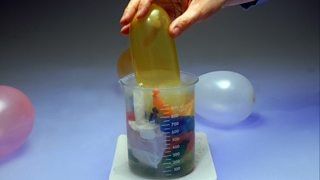What Are There Geometric And/or Organic Shapes In The Gas Edward Hopper Painting
Temperature and gas calculations
Temperature can be measured using the Celsius and Kelvin scales. Gas pressure increases with temperature. Equations explain the relationship between pressure, temperature and volume in gases.
Volume and pressure in gases – the gas laws
Boyle's law
Decreasing the volume of a gas increases the pressure of the gas. An example of this is when a gas is trapped in a cylinder by a piston. If the piston is pushed in, the gas particles will have less room to motion as the book the gas occupies has been decreased.
Because the volume has decreased, the particles will collide more than frequently with the walls of the container. Each time they collide with the walls they exert a force on them. More than collisions mean more force, then the pressure level will increase.
When the volume decreases, the pressure increases. This shows that the pressure of a gas is inversely proportional to its volume.
This is shown by the post-obit equation - which is often chosen Boyle's law . It is named afterward 17th century scientist Robert Boyle .
P 1 V 1 = P 2 V 2
where:
P 1 is the initial pressure
5 1 is the initial book
P 2 is the last pressure
Five two is the last volume
It can also be written as:
pressure 1 × book 1 = pressure two × volume 2
Note that volume is measured in metres cubed (m 3 ) and pressure in pascals (Pa).
It means that for a gas at a constant temperature, pressure level × volume is besides constant. So increasing pressure from force per unit area ane to force per unit area 2 ways that volume one volition change to volume 2 , providing the temperature remains constant.
- Question
-
A sealed syringe contains ten × 10 -6 thousand iii of air at one × 10 5 Pa . The plunger is pushed until the volume of trapped air is four × x -six yard 3 . If there is no change in temperature what is the new pressure of the gas?
-
P i = one × ten 5 Pa
V 1 = ten × 10 -6 1000 3
5 2 = 4 ten 10 -half-dozen m iii
P 1 V 1 = P 2 Five two
Therefore:
\[p_{ii} = \frac{p_{1}{V_{i}}}{V_{two}}\]
\[p_{ii} = \frac{{1 \times ten^{five} \times 10 \times 10^{-half-dozen}}}{4 \times 10^{-half-dozen}}\]
P 2 = 2.5 × x 5 Pa
The new pressure in the syringe is 2.5 × 10 5 Pa
Charles' law
Charles' law describes the event of changing temperature on the volume of a gas at constant force per unit area. It states that:
\[volume_{1} = volume_{ii} \times \frac{temperature_{1}}{temperature_{2}}\]
\[V_{1} = V_{2} \times \frac{T_{1}}{T_{2}}\]
where:
V 1 is the initial book
V 2 is the last volume
T ane is the initial temperature
T 2 is the final temperature
Note that volume is measured in metres cubed (thou 3 ) and temperature in kelvin (K).
This means that if a gas is heated upward and the pressure does not alter, the book will. So for a fixed mass of gas at a abiding force per unit area, book ÷ temperature remains the same.

Source: https://www.bbc.co.uk/bitesize/guides/zc4xsbk/revision/3
Posted by: woodruffturitch.blogspot.com


0 Response to "What Are There Geometric And/or Organic Shapes In The Gas Edward Hopper Painting"
Post a Comment